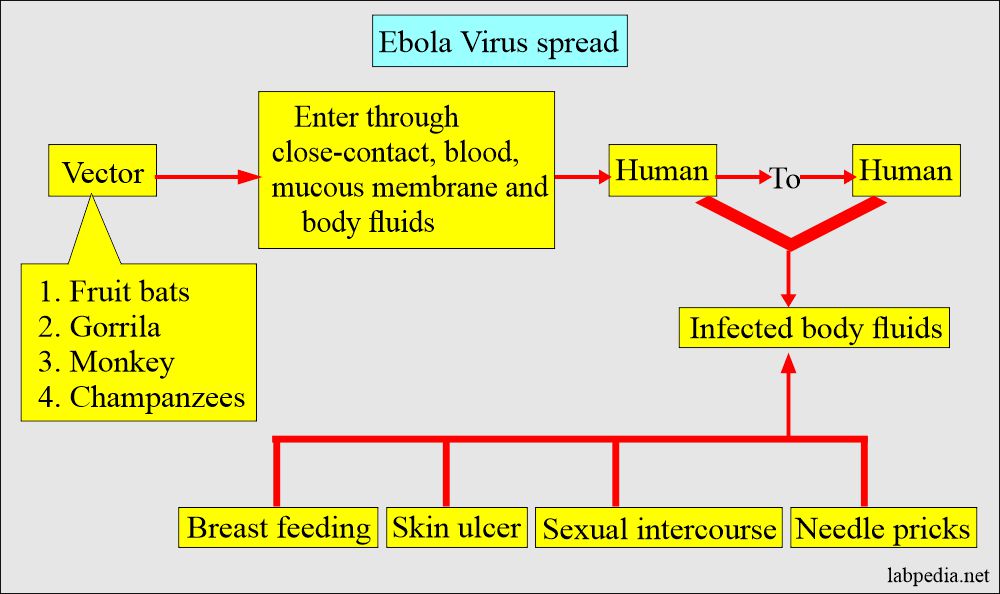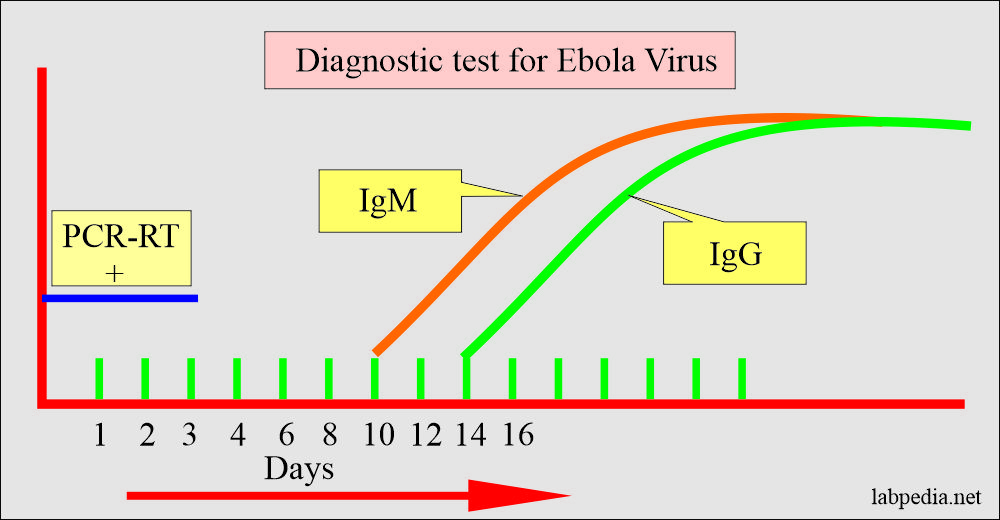Ebola Virus (Hemorrhagic Fever)
Ebola Virus
What Sample is needed for the Ebola Virus?
- This can be diagnosed with patient blood, sputum, and tissue.
How will you define the Ebola virus?
- Ebola virus is a rare and deadly disease in humans and nonhuman pirates.
- It is fatal in humans.
- It is mainly seen in the sub-Saharan Africa.
How will you describe the Epidemiology and History of the Ebola virus?
- Ebola virus, formerly called Hemorrhagic fever.
- This disease spreads from wild animals (rodents).
- Also, this disease spreads from human to human.
- The fatality rate varies from 25% to 90%, and the average is around 50%.
- This disease outbreak is seen in remote villages of Central Africa near the tropical rainforest.
- The first outbreak was seen in 1976 in Sudan, Congo.
- The first case was identified along the Ebola River in Congo near the Sudan border.
- This was seen near the Ebola River in Congo, and it got its name from there.
- These cases have been reported from Senegal, Nigeria, Mali, Italy, Spain, the United States of America, and the United Kingdom.
- Ebola virus details were given on April 4, 1995.
- A patient was reported in Kikwit city of Zare. He was a laboratory technician who developed a fever and severe headache.
- He has abdominal cramping pain, which settles later on. He has difficulty swallowing. Then he has blood in the stool, and later on, blood from the nose and mouth starts.
- Within 2 weeks, his other workers developed similar signs and symptoms.
- Fever = 94%, diarrhea = 80%, weakness = 74%, dysphagia = 41%, hiccups = 15%, and bleeding from the mucous membranes of GITract, vagina, and skin = 38%.
- By June, there were 296 cases.
- Samples were sent to the CDC, and samples were subjected to PCR and immunoabsorbent assay; the report was positive for the Ebola virus.
- Filo, in filoviridae, means filament in Latin and describes the filamentous shape of the RNA viruses Ebola and Marburg, which is part of the filovirus family.
What is the Transmission of the Ebola virus?
- The host is bats (Pteropodidae family).
- This virus spreads through close contact with an infected animal’s blood, secretions, and body fluids, such as chimpanzees, gorillas, monkeys, and fruit bats.
- Ebola virus then spreads through human-to-human transmission via:
- Direct contact (through broken skin or mucous membranes).
- Through the blood, secretions, organs, or other body fluids of infected people and with surfaces and materials (e.g., bedding, clothing) contaminated with these fluids.
- Humans and monkeys are infected during outbreaks of this disease, but the reservoir source is unknown.
- Healthcare workers:
- They have frequently been infected while treating patients with suspected or confirmed Ebola virus infection.
- This has occurred through close contact with patients when not strictly practiced infection control precautions.
- People remain infectious:
- As long as their blood and body fluids contain the virus, including semen and breast milk.
- Men who have recovered from the disease can still transmit the virus through their semen for up to 7 weeks after recovery from illness.
- So, the main source of the spread is direct contact with body fluids.
- Direct contact with blood, urine, stool, vomitus, or semen from active disease patients, alive or dead, is the most important transmission source.
- This occurs through the skin or mucous membrane contact with virus-infected body fluid.
- The reuse of unsterile needles was the main source of spread in the Kikwit, Zaire patients.
What are the Types of Ebola Viruses?
- Filo means filaments in Latin, describing the filamentous shape of the RNA Ebola and Marburg virus belonging to the filovirus group.
- Ebola is a single-stranded RNA.
- The virus family Filoviridae includes 3 genera:
- Cuevavirus.
- Marburg virus,
- Ebola virus.
What are the Species of the Ebola virus?
These are identified as follows:
- Zaire Ebola virus.
- Bundibugyo Ebola virus.
- Sudan Ebola virus.
- Reston Ebola virus.
- Taï Forest ebolavirus.
- The first 3, Bundibugyo ebolavirus, Zaire ebolavirus, and Sudan ebolavirus, have large African outbreaks.
- In another reference, three clinically active viruses are Zaire, Sudan, and Tai forest.
- The virus causing the 2014 West African outbreak belongs to the Zaire species.
- The first 3, Bundibugyo ebolavirus, Zaire ebolavirus, and Sudan ebolavirus, have large African outbreaks.
What is the incubation period of the Ebola virus?
- It is 2 to 21 days before symptoms appear.
What are the signs and symptoms of the Ebola virus?
- The average time for S/S to appear is 8 to 10 days.
- 95% will have a sign and symptoms during the first 14 days.
- Humans are not infectious until they develop symptoms.
- There is a sudden onset of:
- Fever.
- There is malaise, fatigue, myalgia, and arthralgia.
- Muscle pain, headache, and sore throat.
- Fever.
- After 3 to 5 days:
- This is followed by vomiting and diarrhea.
- Rash.
- There are symptoms of impaired kidney and liver function.
- In some cases, internal and external bleeding (e.g., oozing from the gums, blood in the stools).
- Nausea and vomiting worsen, cannot tolerate oral intake.
- Diarrhea becomes a large volume, and patients may lose 5 or more liters of fluid per day.
- The disease progresses, and the patient may develop neurological symptoms.
- Encephalitis is accompanied by confusion, agitation, and occasional seizures.
- The patient may go into shock.
- Hemorrhagic manifestations are seen in only 1 to 5% of the cases.
- A complication of the Ebola virus:
- There is a hypovolemic shock.
- There may be a multiorgan failure.
How will you diagnose the Ebola virus?
Laboratory findings of the Ebola virus include:
- Blood sample:
- Low white blood cell and platelet counts.
- Abnormal Liver function tests.
- Increased serum creatinine level.
- Serological tests:
- ELISA (antibody-capture enzyme-linked immunosorbent assay):
- IgM antibodies appear after 10 days of the infection.
- After 2 weeks, IgG antibodies appear.
- Serum neutralization test.
- Antigen-capture detection tests.
- PCR-RT (Reverse transcriptase-polymerase chain reaction assay) can diagnose in the first three days of illness
- Repeat this test if negative and the patient still has signs and symptoms.
- Electron microscopy will detect the virus.
- Culture can isolate the virus.
How will you Prevent the Ebola virus?
- There is no available vaccine.
- There are vaccines under trial.
- If you travel to or are in an area affected by an Ebola outbreak, make sure to do the following.
- Practice careful hygiene. Avoid contact with blood and body fluids.
- After you return, monitor your health for 21 days and seek medical care immediately if you develop signs and symptoms of an Ebola virus infection.
- Avoid hospitals where Ebola patients are being treated.
- Avoid contact with bats and nonhuman primates or blood, fluids, and raw meat prepared from these animals.
- Avoid funeral or burial rituals that require handling the body of someone who has died from Ebola.
- Do not handle items that may come into contact with an infected person’s blood or body fluids.
How will you treat the Ebola virus?
- This is mainly supportive.
- Rehydrate the patient, and that may reduce mortality.
- Antiviral drugs may be tried.
- People sometimes give antimalarial and broad-spectrum antibiotics.
Questions and answers:
Question 1: What are the species of the Ebola viruses?
Question 2: What is the blood picture in the Ebola virus?




